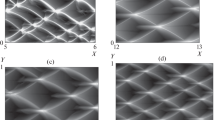A numerical simulation of the conditions for the direct initiation of detonation in the region of a combustible mixture, in which its critical energy is minimum, has been performed using a streamer microwave discharge for the source of detonation initiation. The calculations were conducted on the basis of the model of the two-dimensional detonation in a combustible mixture, flowing in a cylindrical channel, with the use of the system of gas-dynamics and chemical-kinetics equations. The process of detonation initiation was considered as applied to a stoichiometric hydrogen–air mixture flowing in a cylindrical channel at different initial pressures. The requirements for the source of initiation of detonation in a combustible mixture were investigated with respect to the attainment of its critical parameters in practice.
Similar content being viewed by others
References
T. V. Bazhenova and V. V. Golub, Use of the gas detonation in a controlled frequency regime, Fiz. Goreniya Vzryva, 39, No. 4, 3–21 (2003).
A. I. Tarasov and V. A. Shchipakov, Use of the pulse detonation technologies for increasing the propulsion efficiency of engines, Obshch. Voprosy Dvigatelestr., No. 2, 69–72 (2010).
J. H. Lee, Initiation of gaseous detonation, Annu. Rev. Phys. Chem., 28, 75–104 (1977).
Yu. A. Bokhon and Yu. V. Shulepin, Minimum energy of initiation of a spherical gas detonation in some hydrogen mixtures, Dokl. Akad. Nauk SSSR, 245, No. 3, 623–626 (1979).
V. V. Mitrofanov, Detonation Theory [in Russian], Novosibirsk. Gos. Univ., Novosibirsk (1982).
J. H. Lee and R. Knystautas, Laser spark ignition of chemically reactive gases, AIAA J., 7, No. 2, 312–317 (1969).
V. A. Levin, V. V. Markov, and S. F. Osinkin, Simulation of the initiation of detonation in a combustible gas mixture by an electric discharge, Dokl. Akad. Nauk SSSR, 261, No. 1, 50–52 (1981).
V. A. Levin, V. V. Markov, and S. F. Osinkin, Initiation of detonation in a hydrogen–air mixture by an explosive-substance charge surrounded by an inert-gas layer, Vestn. Moskovsk. Gos. Univ., Mat. Mekh., No. 6, 32–34 (1997).
A. A. Vasil’ev and V. A. Vasil’ev, Diffraction of waves in combustible mixtures, J. Eng. Phys. Thermophys., 83, No. 6, 1178–1196 (2010).
A. N. Dremin, Toward Detonation Theory, Springer, New York (1999).
V. P. Korobeinikov and V. A. Levin, Strong explosion in a combustible gas mixture, Izv. Akad. Nauk SSSR, Mekh. Zhidk. Gaza, No. 6, 48–51 (1969).
V. V. Mitrofanov and S. A. Zhdan, Propulsion characteristics of an ideal pulse detonation engine, Fiz. Goreniya Vzryva, 40, No. 4, 8–14 (2004).
R. Knystautas and J. H. Lee, On the effective energy for direct initiation of gaseous detonations, Combust. Flame, No. 27, 221–228 (1976).
K. Ya. Troshin, Energy of initiation of diverging detonation waves, Dokl. Akad. Nauk SSSR, 247, No. 24, 887–889 (1979).
A. A. Vasil’ev, Energy aspects of the initiation of domestic gases, Fiz. Goreniya Vzryva, 45, No. 1, 96–101 (2008).
C. K. Westbrook and F. L. Dryer, Chemical kinetic modeling of hydrocarbon combustion, Prog. Energy Combust. Sci., 10, No. 1, 1–57 (1984).
R. Takai, K. Yoneda, and T. Hikita, Study of detonation wave structure, Proc. 15th Int. Symp. Combust., 25–31 August 1974, Tokyo, Japan, Pittsburgh (1975), pp. 69–78.
K. V. Khodataev, The numerical modeling of the air supersonic flooded jet with deep undercritical microwave discharge, Proc. 4th Workshop on Magneto-Plasma Aerodynamics in Aerospace Applications, 6–11 April 2002, Moscow, Russia (2002).
P. V. Bulat, I. I. Esakov, L. P. Grachev, K. N. Volkov, and I. A. Volobuev, Experimental study of air breakdown induced by subcritical streamer microwave discharge, IEEE Trans. Plasma Sci., 49, No. 3, 1041–1049 (2021).
P. V. Bulat, K. N. Volkov, L. P. Grachev, I. I. Esakov, and P. B. Lavrov, Decrease in the threshold of the breakdown of air by the subcritical streamer discharge in the case where its initiator is positioned near a metal shield, Pis’ma Zh. Tekh. Fiz., 48, No. 6, 41–43 (2022).
P. V. Bulat, K. N. Volkov, L. P. Grachev, I. I. Esakov, and P. B. Lavrov, Influence of the pressure and composition of the fuel mixture on its ignition by a subcritical streamer discharge, J. Eng. Phys. Thermophys., 95, No. 4, 931–938 (2022).
Author information
Authors and Affiliations
Corresponding author
Additional information
Translated from Inzhenerno-Fizicheskii Zhurnal, Vol. 96, No. 6, pp. 1481–1486, November–December, 2023.
Rights and permissions
Springer Nature or its licensor (e.g. a society or other partner) holds exclusive rights to this article under a publishing agreement with the author(s) or other rightsholder(s); author self-archiving of the accepted manuscript version of this article is solely governed by the terms of such publishing agreement and applicable law.
About this article
Cite this article
Bulat, P.V., Volkov, K.N., Grachev, L.P. et al. Conditions of Initiation of Detonation in a Stoichiometric Hydrogen–Air Mixture by a Streamer Discharge. J Eng Phys Thermophy 96, 1468–1473 (2023). https://doi.org/10.1007/s10891-023-02815-9
Received:
Published:
Issue Date:
DOI: https://doi.org/10.1007/s10891-023-02815-9



